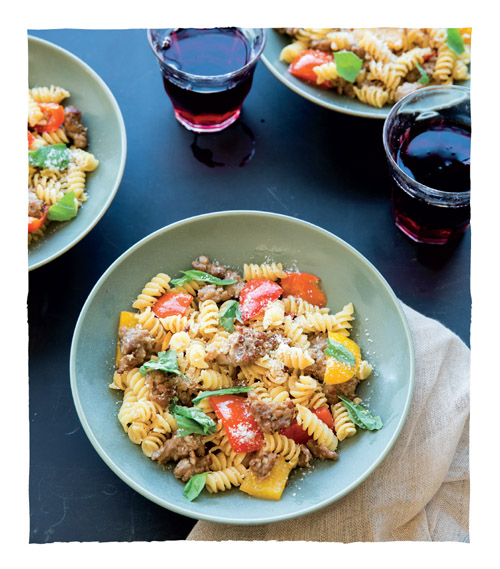LARGE POT Choose a tall, narrow pot large enough to accommodate 5–6 qt (5–6 l) water comfortably, with plenty of room for the pasta to cook at a rolling boil without sticking together.
LARGE COLANDER Look for a sturdy colander with feet, so it can be placed in the sink for hands-free draining.
METAL TONGS & WOODEN SPOON Both tools are ideal for stirring and serving pasta. Tongs work best for dishes featuring long noodles, such as spaghetti, while a long-handled wooden spoon is handy for stirring sauces and serving short noodles or pasta shapes.
BAKING DISH An ovenproof dish that is also beautiful is a one-pot solution for baked pastas. Don’t forget to protect your dining table from the heat of the dish with a trivet.
CHEESE GRATER A box grater, which allows you to grate and shred cheeses into a variety of different consistencies, is great for kitchen use. A handheld grater is nice to have when you want to pass around a wedge of cheese for grating at the table.
STOCK YOUR INGREDIENTS Always keep an array of basic ingredients–dried pastas, olive oil, olives, capers, anchovies, artichoke hearts, onions, garlic–in the pantry or refrigerator. If time permits, make a trip to your local farmers’ market or Italian deli to pick up a few special ingredients, such as a wedge of Italian-imported Parmesan cheese, seasonal fresh vegetables and herbs, or fresh pasta.
MATCH YOUR PASTA AND SAUCE Review Pairing Pastas and Sauces on see recipe to make sure your pasta and sauce will complement each other.
PLAN AHEAD Set out everything you’ll need for the recipe–tools and ingredients–before you start cooking, then prep any ingredients and put the water on to boil. Never add the pasta to the boiling water until you are sure the sauce and any toppings are ready or nearly ready for serving. That way you won’t end up with cooked pasta that has sat too long and clumped together.
SEASON FROM THE INSIDE To ensure a well-seasoned pasta dish, salt the pasta cooking water until it is almost as salty as seawater. Always use plenty of water (5–6 qt/5–6 l for every 1 lb/500 g of pasta) and make sure it is at a full rolling boil before you add the pasta.
ACHIEVE AL DENTE PERFECTION Pasta is best cooked al dente, literally “to the tooth” in Italian, which means the pasta noodle or shape should be tender but still firm to the bite. If using dried pasta, follow the package instructions, then sample a piece 1–2 minutes before the suggested cooking time is reached. If using fresh pasta, cook for the minimum amount of time indicated in the recipe, then sample a piece.
SAVE SOME COOKING WATER Before draining the pasta, reserve about 1 cup (8 fl oz/ 250 ml) of the cooking water in a measuring pitcher or bowl. This starchy water can be used later to help adjust the consistency of the sauce.
USE CHEESE LIGHTLY AT FIRST Have cheese at room temperature before adding it to a pasta dish, to ensure it blends in easily and does not cool down the pasta. Add just a touch of grated cheese to begin with, then pass additional cheese at the table. If grating the cheese yourself, wait until just before serving, for maximum freshness.
